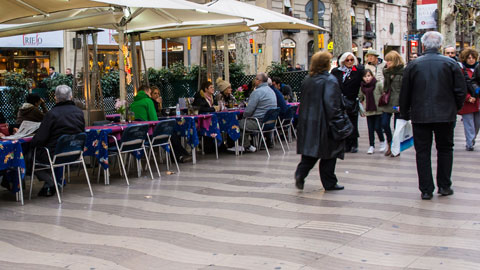Living in areas with more services is beneficial to active, healthy ageing

01/10/2015
Elderly persons who live in districts with more services and shops lead less sedentary lives, doing more walking and over longer distances. This is indicated by a study conducted by researchers from the Institute of Environmental Science and Technology (ICTA-UAB) and the UAB Department of Geography, which clearly shows that the urban design of the different districts and municipalities that make up the Barcelona Metropolitan Region has a direct influence on the levels of physical activity displayed by their older residents.
The progressive ageing of the population and the high degree of dependency among over-65s pose a problem for many countries in Europe, which are now working to implement health policies that promote active ageing, through physical activity and healthy mobility. Lack of physical activity is a key risk factor for obesity, mental illnesses, cardiovascular issues, different types of cancer and arthritis, which account for 6% of mortality. This study shows that 15.5% of over-65s spend more than one day without leaving the house, a figure that rises to 21.2% in the case of over-75s, and even higher in that of older women: 25.5%. In response to this, walking is suggested as a preventive activity that is effective, safe and accessible to the elderly.
Carried out by ICTA-UAB researcher Carme Miralles and Oriol Marquet of the Department of Geography, the study analyses how the make-up of the urban environment – not only age and gender – can influence the number of trips that the elderly make, and thus the amount of exercise they get. The research was conducted in 164 municipalities in the Barcelona Metropolitan Region, by means of an extensive survey of 12,000 people living in districts classified as "vital" (very busy, with their own facilities and services) or "non-vital" (more isolated, more spread out and less busy).
The results confirm that living in a vital urban environment helps elderly persons to develop healthy mobility habits, as the proximity of their destinations and the presence of other people on the streets encourages them to get out more, which means they walk more often and over longer periods than their counterparts in non-vital areas.
This direct link between a district's vitality/accessibility and active ageing is more marked, however, in elderly men than in women. More specifically, in the non-vital districts, 20% of male over-75s are "immobile" (never leaving the house) while in vital districts the figure drops to 13%. Likewise, men living in areas classified as vital make 11.3% more trips per day than those in more isolated areas.
Over-65s living in vital districts make 76.7% of their trips on foot, a figure that falls to 56.8% in non-vital areas. Meanwhile, privately-owned cars are used for only 10.2% of trips starting out in vital districts, compared to 20.3% in the case of non-vital districts.
The results show that men walk for more minutes than women (86.6 and 57.7, respectively). Living in a vital environment means walking 20% more, since an average 4.8 more minutes per day are spent walking (72.1 minutes in vital districts and 67.3 minutes in non-vital ones). By the end of the week these residents have walked for almost 34 more minutes. It can be said, therefore, that those living in vital districts are closer to reaching the WHO recommendation of 30 minutes' walking per day as a way to active, healthy ageing.